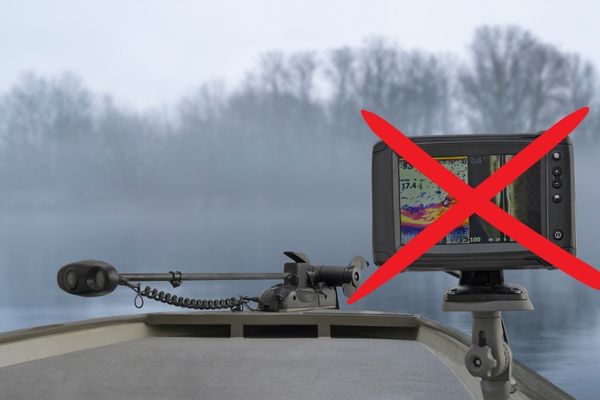I have been kayak fishing for years, and most of the time I do not use a fish finder but I can still consistently get onto trout and many other species of fish.
The reason why I don,t use a fish finder is that I often kill mine, and also out of stubbornness. I like the challenge of not relying on electronics. I also spend a lot of time trolling, where sounders are not really that big of a help.
So unless I absolutely need a fish finder, I typically leave mine at home. Not relying on electronics forces me to be more in touch with my surroundings.
In this article, I will share some hints on how I find fish despite not using a fish finder.
When I feel a fish finder is important
I still use a fish finder when fishing deep, featureless water that is generally far from shore. They are also useful in areas I have not fished before.
1) Fish close to the shore – focus on visual structure and cover
This is a big one and certainly applies to trout. Unless the water temperature is high, trout spend most of their time in the shallows. For this reason, I spend most of my time fishing close and casting towards the shore.
It is not only trout that prefer shallow water, many species actually do.
The reason is simple, this is where most of the food is. The sun rays illuminate the bottom, allowing plants to grow that feed the aquatic insects, the plants also provide shelter for smaller bait fish. So the area of a lake close to the shore is often the most productive.
For the same reasons, shallow flats are also very productive.
2) Experience
This one is cheating, spend enough time fishing your local waters and it becomes possible to memorize where the fish and underwater structure is. I also remember previous locations by taking bearings from various line marks, maybe spot X is half between the dead tree and the big boulder.
I have been fishing my home waters for so many years, which has allowed me to broadly memorize where the ‘permanent’ underwater structure is. I can paddle to their general position from just memory alone. I then use my memorizes bearings to position myself over the spot. (can also mark the spots using your phone GPS)
If I am visiting a new lake, I always check the Nautical charts and make a mental knot of any interesting features. (Or upload the coordinates to your phone)
I am far from the only person who can find spots from memory. I once went out on a bluewater charter trip with an extremely experienced captain. All without electronics, the captain motored offshore for about forty minutes, before slowing down and positioning his boat over a featureless piece of water. He then told everyone to start fishing, within minutes most rods were bending over with fish on. The fishing was intense for a few minutes before dying. We have drifted off the spot. He then motored back around and positioned the boat again for another drift.
We were far from land, and there were no features to work with but he had the ability to put us on the spot. If I had to guess, we were fishing over a long underwater ridge, and he could locate it by just compass direction and ‘distance’ alone.
3) Know that land features continue into the water
The contour and ridges of the land typically continue out into the water. Where there is a point, there will nearly always be a reef, where there is a smooth beach, there will likely be a shallow flat.
If there is a random island off the end of a point, I can almost guarantee the two are connected by a reef.
In areas of high currents, holes can form down-current of a structure, the structure blocks the current causing it to speed up as it flows over it scouring away the sediment from the downstream side.
In rivers, the inside of bends are shallow, while the outside of bends are scoured out into deep holes.
4) Look for feeding fish or birds
Fish often give away their own location by leaping out of the water. When I see bait fish leaping from the surface, chances are something bigger is chasing them The more bait activity, on the surface the more likely there will be predatory fish nearby.
In a similar fashion, keep an eye on predatory birds. They have much better eyesight and an aerial view. They often know where the fish are and will dive down to catch them. I have gotten onto some great fishing just by watching birds and where they are feeding.
I could probably write a whole article on observing birds while fishing, but I will give some basics. – If the birds are circling around, and diving down then the fish are near the surface.
– If the birds are circling, but not diving, it means they can see the fish but they are too deep. How deep is too deep, well that really depends on the bird. An eagle can dive about six inches, Osprey, a couple of feet, gannets can get down to 72ft, and cormorants between 25-150ft (species dependent)
– If the birds are just flying straight, it means they are heading towards fish or heading to their roost. Probably not worth following.
– When they just laze about means there are no fish, or they are not hungry.
5) Observe/follow other anglers
My feelings are mixed about this one, it is often the blind leading the blind, but I know plenty of people do it. It is also a bit annoying, When I am out on the water enjoying the tranquillity I hate it when boats start clustering around.
If the original boat knows where the fish are, then it can also put the following boat onto them as well, but often it seems to be the blind leading the blind.
I remember early one long weekend, I was out with an acquaintance fishing, and he said watch this, before anchoring up some random spot. Within about 10 minutes another boat joined us, and half an hour later there were four nearby. He then motored off leaving the group of boats behind. There were boats on that location for the rest of the day.
So it is important to know, that just because there is a cluster of boats, does not necessarily mean they know what they are doing or if the fishing is any good.
6) Changes in water color typically indicate a drop-off
Generally speaking, deeper water is a darker hue than water that is shallower. When there is a sudden drop-off the water can appear darker.
With that said, I sometimes find the changes in color is easier to see from the shore than on the water, up close it all blends together a bit more.
7) Look for branches poking out of the water
In shallower water, it is often possible to see tree trunks and the likes under the water, sometimes there are a few twigs poking out, or the current splits around them causing turbulence. These submerged trees are an excellent place to land a few casts.
I have also found submerged trees by trolling along and suddenly getting snagged.
8) In human powdered boats, shallow water makes the paddling harder.
When kayaking, shallow water feels a lot more sluggish to paddle across than deeper water. Once you are aware of it, it is quite noticeable.
So If I am happily paddling along, and for little apparent reason the kayak suddenly starts to slow and feel more difficult, chances are that the water has suddenly gotten shallower.
Likewise, if the paddling suddenly becomes easier, chances are the water is now deeper. This affect is normally noticeable when water is six feet of shallower, and the amount of drag increases as the depth increases.
9) Use a marked line to measure water depth.
This process is a bit time consuming, and I find it extremely boring. So I do not personally do it. But it is possible to measure the depth of water, by dropping a weighted length of rope or line overboard, marked with distance measurements.
To make things simple, there is actually fishing with different color sections designed for judging depths. While the line is meant for jigging, it can also be used to determine depth.
I also know people who drop ‘grappling hooks’ down on ropes, they then use the hook to try and snag water weeds, by using this method it is possible to pinpoint the location of weed banks and their edge.
8) Look for floating weed
Looking for, and cast around large clumps of floating weed or debris. Even in deep water some predatory fish like to shelter and ambush prey while hiding beneath objects floating on the surface.
I do not believe this technique works for trout specifically, but it does work for some other species.
9) Just drift and fish
I often just drift around aimlessly and fish. I will cover the surface, or jig further down. It takes a lot of time, but I enjoy fishing so it goes quickly.
Sometimes, by doing so I can pick up the smallest of structures, maybe just a line of baseball size rocks in a sandy desert. Such small structures rarely show up even with a sounder, but they can be full of fish.
I have jumped in and dived into some of these locations, and there is not normally much there. A couple of inches of elevation change, an outcrop of small stones, or even spring eruption zones.
10) Look for the ‘bubbles’ of springs on the surface
The floor of a lake is rarely uniform, there are often small springs or other features. During hot weather, trout will often gather around springs to escape the heat.
On extremely calm days, it is sometimes possible to see the ‘bubbles’ from springs disturbing the surface. Such spots are certainly worth remembering.

